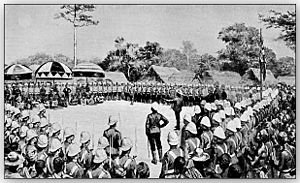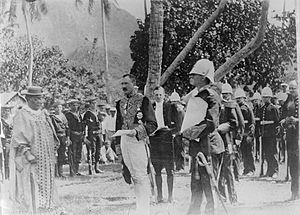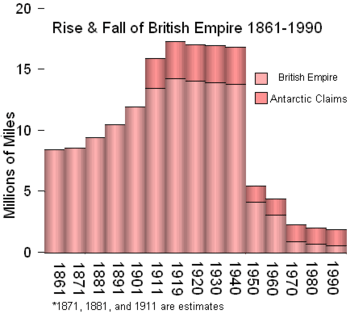Territorial evolution of the British Empire facts for kids
The British Empire was a huge collection of lands and peoples around the world that were once ruled or controlled by the United Kingdom. It started in the late 1500s when England began setting up colonies overseas.
When the Kingdom of Great Britain was formed in 1707 (by joining England and Scotland), all of England's colonies became part of Great Britain. Later, in 1801, Great Britain joined with Ireland to form the United Kingdom of Great Britain and Ireland. The new United Kingdom then took control of all these lands. These territories together were known as the British Empire.
Even though the kings of Britain from 1714 to 1837 also ruled a German state called Hanover, Hanover was not considered part of the British Empire. It was a separate country.
The way the British Empire ruled its territories was very different from place to place. Some lands were directly owned by the British monarch, who was also called the Emperor or Empress of India for a time. Other places were "protectorates," meaning Britain protected them but didn't fully own them. There were also territories managed by Britain under agreements with the League of Nations or the United Nations.
Many countries that were part of the British Empire slowly gained their independence in the 1900s. A big wave of independence happened after World War II, starting with India and Pakistan in 1947. The process continued until Hong Kong was returned to China in 1997.
Today, there are still fourteen territories around the world called the British Overseas Territories. These lands are still connected to the United Kingdom.
Many former parts of the British Empire are now members of the Commonwealth of Nations. This is a group of independent countries that work together. Fourteen of these countries still have the British monarch (currently Charles III) as their head of state. The British monarch is also the Head of the Commonwealth, but this is a symbolic role, and all Commonwealth members are fully independent countries.
Contents
How the British Empire Was Governed
The British Empire included many different types of territories, each with its own way of being managed. There wasn't one single system that applied to all of them.
Colonies: Settled Lands
Colonies were territories meant for people from Britain to settle in permanently. Britain claimed full control over these lands, but they were not officially part of the United Kingdom itself. Over time, some colonies were given "responsible government," which meant they could mostly govern themselves.
Crown Colonies: Ruled by the Crown
A Crown colony was a type of territory where the British monarch (the Crown) directly controlled the government and laws. A governor, appointed by the monarch, ruled these colonies.
By the mid-1800s, the monarch appointed governors based on advice from the Secretary of State for the Colonies. Most Crown colonies, especially those with many white settlers, had two parts to their law-making body (legislature). An upper house, called the Legislative council, had appointed members, similar to the British House of Lords. A lower house, often called the Legislative Assembly, was usually elected. However, only free white men, usually those who owned property, could vote.
The governor also had an Executive Council, which was like a Cabinet in Britain but didn't answer to the colonial lower house. Its members gave advice and were usually from the upper house. As white colonies gained more self-government, the elected lower house became more important than the upper house, and a leader called the Premier emerged.
Charter Colonies: Rules from a Royal Document
A charter colony was a type of government in the early English colonies in North America. The King gave a special document, called a royal charter, to the colonial government. This charter explained how the colony should be governed. Charter colonies could elect their own governors based on the rules in the charter.
Proprietary Colonies: Owned by Individuals
Some colonies in the 16th and 17th centuries were given to a specific person. These were called proprietary colonies. In America, a "Lord Proprietor" governed these colonies. They had a lot of power, almost like an independent ruler, because of the royal charter they held. Eventually, many of these became Crown colonies.
Chartered Companies: Trade and Control
A chartered company was a group of investors or shareholders who formed a company for trade, exploration, and setting up colonies. These companies were usually given a royal charter by the monarch. This document explained their trading rights, areas of influence, and responsibilities.
Some famous examples include the East India Company, the Hudson's Bay Company, and the Royal African Company. These companies sometimes ruled large areas. For instance, the East India Company controlled vast parts of India. The Hudson's Bay Company took over the Hudson Bay drainage basin in Canada, known as Rupert's Land. The Royal African Company was involved in shipping enslaved people from West Africa to the Americas.
Protectorates and Protected States: British Protection

A protectorate was a territory that Britain didn't officially take over, but where the British Crown had power and control through agreements. A protectorate was different from a "protected state." A protected state was a territory ruled by a local leader, but Britain protected it and controlled its foreign affairs. Britain did not interfere with its internal matters.
Dominions: Self-Governing Nations
Dominions were semi-independent countries that were still officially under the British Crown. They were part of the British Empire and later the Commonwealth of Nations. This began in the late 1800s. Many dominions were formed by joining several Crown colonies, like the Union of South Africa and the Commonwealth of Australia.
The Balfour Declaration of 1926 made it clear that dominions were "autonomous Communities within the British Empire, equal in status." This meant they were independent in their own affairs but shared loyalty to the Crown and were part of the British Commonwealth. The Statute of Westminster 1931 made this legal, making them essentially independent members of the British Commonwealth.
At first, dominions managed their own trade, some foreign relations, and had their own armies. However, Britain still had the power to declare wars. After the Statute of Westminster, the idea of being dependent on the UK Crown changed. The Crown was simply "the Crown," not specifically the British Crown. Countries once called "Dominions" became Commonwealth realms, where the monarch reigns as the monarch of that specific nation, equal to the United Kingdom.
Mandates: Territories after World War I
Mandates were territories created after World War I. Some German colonies and Ottoman provinces were given to the United Kingdom and its dominions to govern. These included Tanganyika, British Cameroons, Togoland, Palestine, and Mesopotamia for the UK. Australia received New Guinea and Nauru. New Zealand received Western Samoa. South Africa received South West Africa.
These territories were managed on behalf of the League of Nations to help their people. Most of them became United Nations Trust Territories in 1946.
Indian Empire: The British Raj
The Indian Empire, also known as the British Raj, was the British political system in the Indian subcontinent from 1858 to 1947. It included:
- British India: These were areas directly ruled by the British Crown through a high-ranking official called the Viceroy and Governor-General of India.
- Princely States: These were states ruled by Indian princes, but they were under the overall authority of the British Crown, also managed by the Viceroy.
British Overseas Territories Today
Within twenty years after India gained independence in 1947, most of the British Empire's territories became fully independent. Today, there are 14 former colonies that are still under British rule. Since 2002, these are known as British Overseas Territories. The term "colonies" is no longer used for them officially.
Almost all British Overseas Territories are islands or groups of islands with small populations. Many are in very remote parts of the world. For territories with people living there permanently, they have some level of self-government. The United Kingdom is still responsible for their defense and foreign relations.
The fourteen British Overseas Territories are:
 Anguilla
Anguilla Bermuda
Bermuda British Antarctic Territory
British Antarctic Territory British Indian Ocean Territory
British Indian Ocean Territory British Virgin Islands
British Virgin Islands Cayman Islands
Cayman Islands Falkland Islands
Falkland Islands Gibraltar
Gibraltar Montserrat
Montserrat Pitcairn Islands
Pitcairn Islands Saint Helena, Ascension and Tristan da Cunha
Saint Helena, Ascension and Tristan da Cunha
 South Georgia and the South Sandwich Islands
South Georgia and the South Sandwich Islands Sovereign Base Areas of Akrotiri and Dhekelia
Sovereign Base Areas of Akrotiri and Dhekelia Turks and Caicos Islands
Turks and Caicos Islands
Images for kids
See Also






